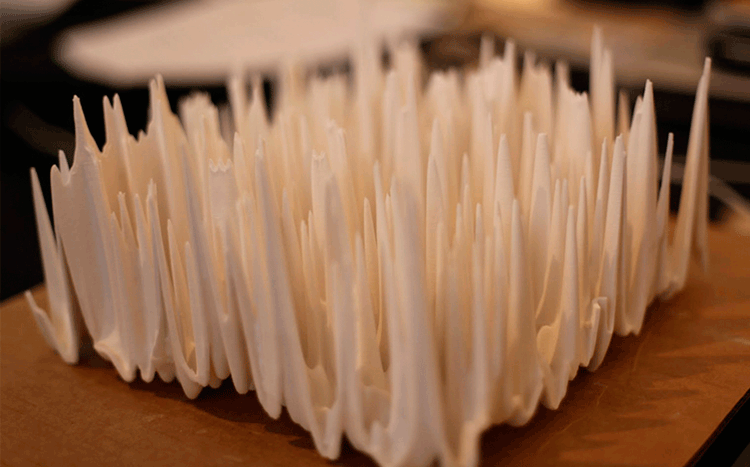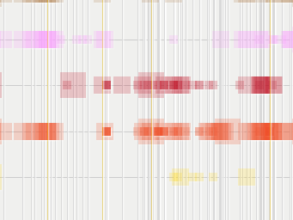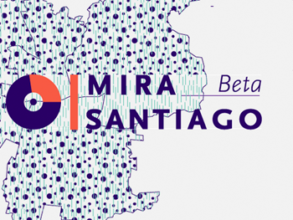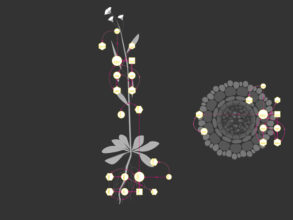Translation and Dematerialization of Data
You are looking at an object that is a manifestation of this text; pure digital information recreated in a physical form. In the context of contemporary new media artwork and the information age, what can be said about the conceptual practice of dematerialization? Is it still relevant in the information age? This project is a proposition that a method by which one may dematerialize a work whose medium is information is to translate the data into a material form. Manuela Garreton and Jack Kalish are two young artists and designers working in the realm of New Media. This text, this object, is a dematerialization of two of their previous works.
In winter of 2010 at NYU’s ITP program, Jack Kalish and Gabriella Levine created Bytelight, an interactive light sculpture. Bytelight allows people to directly manipulate digital information through a series of light switches, whose state gets translated into an overhead light, bathing the visitor in color. The work represents a “rematerializtion” of immaterial digital data in the form of the real, physical phenomena of colored light.
At the same period Manuela Garreton developed a project called Plant Reader, consisting of a program that extracts information from photographs of plants that she had taken during her previous experience as a graphic researcher in a Plant Biology Lab. These analyses consisted of going trough every photograph, reading the associated data on every pixel of the image, and then visualizing this information as a graph. The process behind this project was taking the information from the real world and transforming it into data that could be used to understand and analyze the growth process within plants.
These two works approach the idea of translation between material and immaterial manifestation of color perception, but from opposing directions. To be more precise, this translation transforms color into values based on the digital information it is associated with. Whereas Bytelight translates digital information about color, creating a physical manifestation of colored light, Plant Reader interprets color information about the natural world and translates it into a digital abstraction and information visualization.
It can be said that the medium of New Media is information, and therefore immaterial. In creating a dematerialization of our work, we have taken this text, which was digitally created on a computer, and have translated the digital data into something purely material. The digital data that forms this text defined the shape of the object, which you are examining.
The conceptualization of this piece was heavily inspired by Luis Camnitzer’s writings on dematerialization and conceptualism in Latin American art. Camnitzer points out to us that in the course of the development of conceptual art around the world “theorization in text form slowly crept into the art itself and became one with the production of art.” (Conceptualism in Latin American Art). With out piece, the text and the object are really inseparable. To create the object, we fed the text, letter by letter into a piece of software that then extruded a three-dimensional plane, based on the byte value (the digital data) that describes each letter. The height of the surface, each bump that you perceive is a character of this text, a discrete bit of information that defines this text. Once the model was generated, it was fabricated using a 3D rapid prototyping printer. This theoretical text that describes the work is in fact the work itself.
For us, dematerialization can be demonstrated in a work of art if its central concept can be expressed through multiple manifestations in different media, as long as the the original concept behind the work of art stays intact. As Sol Lewitt said in “Paragraphs on Conceptual Art” about a conceptual work of art “no matter what form it finally may have it must begin with an idea. It is the process of conception and realization with which the artist is concerned.”
The works that we have dematerialized, Bytelight and Plant Reader, are related to each other because their shared central concept is that of the translation of information. To create this object that you are now reading we started by taking this concept behind out works, and then translating the process that led us to create this new work. The process that took us from our primary work into this new one was registered as written language. The translation to create a set of rules by, systematically executed by a computer program to transform the text into a physical object. Like Donald Judd’s “Specific Object,” the work of art then becomes an explanation of itself and a justification of its own existence.
The medium in the new media is information, and after doing this exercise of dematerialization of information we can say that information could be the most dematerialized medium, we can say it is completely immaterial. So, working in the new media realm is inherently conceptual. New media gives us the possibility to start from the idea.






